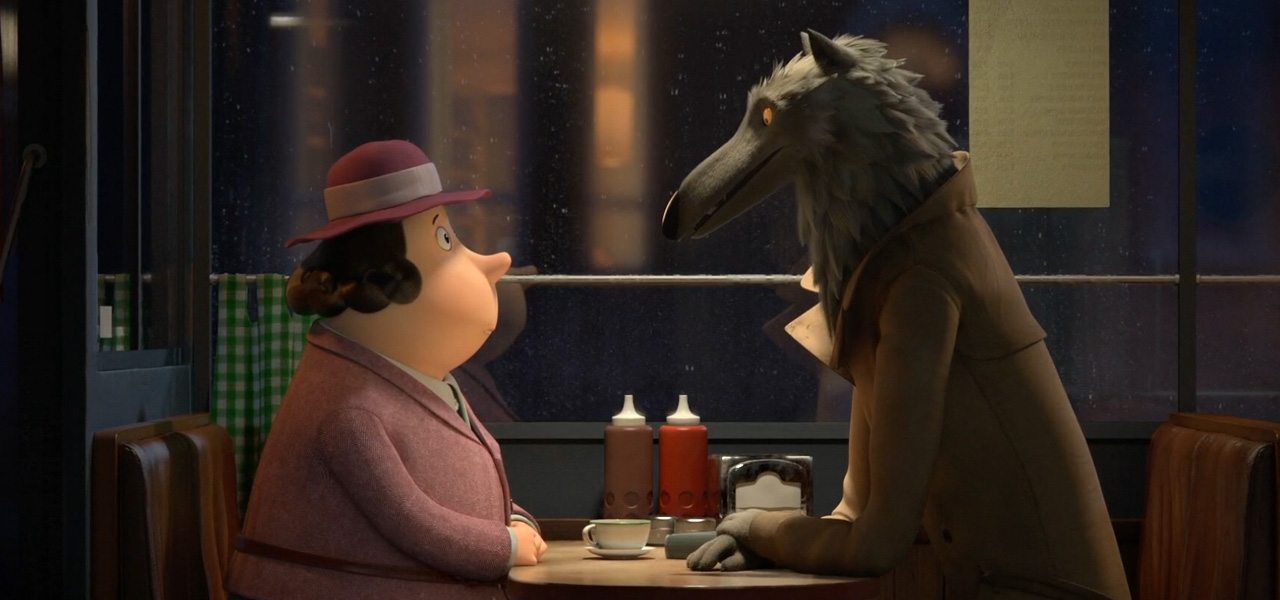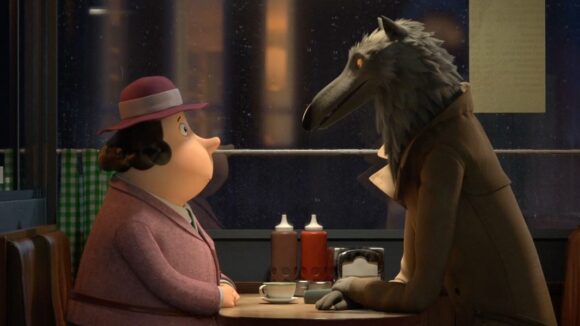

From Book To Animation: What It Took To Adapt Roald Dahl’s ‘Revolting Rhymes’
Revolting Rhymes was recently short-listed by the Academy of Motion Picture Arts and Sciences in the animated shorts category for the 90th Academy Awards. Originally broadcast as two episodes on the BBC, the production is an adaptation of the book by Roald Dahl that was illustrated by Quentin Blake. It was helmed by directors Jakob Schuh and Jan Lachauer, and made by Magic Light Pictures, the company behind The Gruffalo.
Revolting Rhymes is a take on classic fairy tales such as ‘Little Red Riding Hood’ and ‘Snow White and the Seven Dwarfs,’ and intertwines the stories of multiple characters, as told by the Wolf to a woman, the Babysitter, in a cafe. It was animated in cg at Magic Light’s Berlin studio and Triggerfish Animation Studios in Cape Town.
Looking back at the large amount of work behind Revolting Rhymes, Schuh and Lachauer told Cartoon Brew about the various challenges they faced in adapting Dahl’s book, including incorporating the original poems, designing the two worlds of the story, finding the right kind of dark humor, and their toughest sequences.
How do you adapt Dahl? Start by literally ripping up his book
In the original poems, Dahl has a very distinct narrator’s voice. That’s something the directors wanted to preserve in their adaptation, but what made this particularly challenging was having the unconnected stories in the book play out simultaneously in a shared universe.
The process began with cutting up the pages of the book and doing what Schuh describes as a “weekend-long reality check.” He further adds, “We weren’t sure whether it was possible at all to jump between the poems without the rhymes losing their flow. We tried out small things, like ‘When will the times of day mentioned in the rhymes, the seasons, et cetera get in the way?’”

Happy to discover it could work, the directors enlisted storyboard artist Max Lang to help figure out the story – this involved among other things gluing 16 giant boards of cheap sound insulation onto a wall and pinning together beats via note cards. “It was a fairly reiterative process,” added Lachauer. “We’d invite both the project’s editor Benjamin Quabeck and Max to give notes. We hoped both of these guys would stay with the project for a long time, so apart from good notes it was a nice way to sync up towards a shared vision.”
A script eventually emanated from those boarding sessions, which had to be approved by the Dahl estate and the producers. Then, thumbnails moved into storyboards, and storyboards into animatics with temp voices, effects, and music. A great deal of time was spent condensing plot lines, before 3d layouts based on the drawn animatic were realized.

Visual design
The film’s main story, which includes a multitude of fairy tale characters, has a particular stylized look and one that at times resembles puppets. This was inspired by a Munich museum the directors regularly visited that happens to house a collection of old marionettes and puppets.
“Some of the marionettes and hand puppets in that collection, their simple shapes and their carved and painted surfaces, and – just as importantly – the simple logic of those old puppet theater stages, the flat set elements with their volumes just painted-on, all that became a big influence when we started imagining the look of our main story,” said Lachauer.


The original artwork of Quentin Blake was, of course, also inspiration, and the directors considered the slightly twisted old puppets they had referenced as “the perfect three-dimensional analogy to Blake’s hilariously expressive poses and his gorgeous, meandering linework,” added Lachauer.
In terms of final production by Magic Light and Triggerfish, rigging and animation for the characters was done in Maya using custom tool-sets from previous Magic Light productions. Blender was used for modelling along with ZBrush and Mudbox for the sculpting and texturing. The chipped-off paint textures on the stage sets were done in Photoshop. Compositing was done in Nuke, and shading and rendering handled in Arnold.

Mixing dark and light
It’s no secret that Dahl’s works were intentionally dark and mischievous, and those moments permeate the film, too. What the directors found, however, was that showing something in this vein would come across as more shocking than saying or writing it. So they had to find ways of making sure it was part of a character’s larger story.
For example, a question that came up in the early stages of the story process was why Little Red Riding Hood, without any warning, kills the third Pig of the ‘Three Little Pigs’ and makes a bag out of him, right after saving him from the Wolf. “Dahl doesn’t give any explanation in his poem,” said Schuh. “He rather brilliantly puts this in the very last rhyme of that story as a mischievous final twist. We knew we had to give our main character a motivation for that pretty brutal behavior, but we really didn’t want to lose the hilarious moment of surprise that this hits you with in the book.”


So the team instead found an emotional set-up for Little Red Riding Hood’s harsh interference with the Three Little Pigs’ story. “The solution was twofold,” said Schuh. “In the book, there’s a wonderful tiny vignette drawn by Blake showing that third Pig talking on the phone, wearing a suit and looking all businesslike. And then, completely unrelated, in Snow White’s story there’s a throwaway-line by Dahl mentioning ‘The Manager of Barclays Bank.’ He’s not an actual character in the book, just an offhand mention in a sweet little rhyme.
“So we combined Quentin’s drawing of ‘a pig in a suit’ with Dahl’s unknown ‘Manager of Barclays Bank.’ The resulting storyline helped further link Snow White’s and Little Red’s story, but also, more importantly, it created a wonderful set up – a greedy, corrupt, and abusive bank manager misappropriating funds to finance dodgy real estate made of twigs and straw. Now, his killing stays hilarious and kind of shocking, but at the same time it doesn’t betray Red’s character arc in the film.”

Toughest scenes
Schuh and Lachauer pinpoint the bringing together of characters and establishing relationships as the hardest aspect of adapting Dahl’s book. Animation-wise, the evolving relationship between Red and Snow White had to be told almost without dialogue, simply because that connection does not exist in Dahl’s book, which means there were no rhymes to go with it.
“To animate emotionally believable scenes without dialogue is always difficult, especially when these bits also have to get across some key bits of story and info,” said Schuh. “If those scenes don’t work the whole story arc collapses.”

“For similar reasons,” added Lachauer, “another challenging bit was the whole frame story between the Babysitter and the Wolf in the cafe. You have two characters sitting together in a very confined space while their relationship undergoes different stages of fear, mistrust, curiosity, amusement, affection, betrayal. They do talk, but they can’t really move about, so again, you’ve limited yourself to a smaller toolbox for these subtle scenes. Ideally our Wolf keeps that Babysitter and the viewer under the same spell, keeps you guessing, so as an animator you have to be quite precise about which signals you have him drop when.”
Visit the film’s Instagram page to see more artwork from the production of “Revolting Rhymes.” The final Oscar nominations in the animated shorts category will be announced on Tuesday, January 23, 2018.





